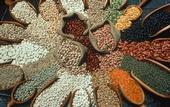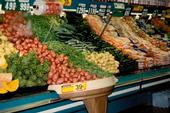- Author: Jeannette E. Warnert

Families today are starved for time, starved for money and starved for well-balanced meals, and USDA projections hold another piece of bad news: food prices are likely to increase 2.5 to 3.5 percent this year.
The good news is there is one powerful five-letter word that will save you money on your food budget, allow you to eat healthier and cook less: beans.
Beans and legumes are a powerhouse of nutrition, heart healthy and very economical. There are endless varieties of beans and legumes and just as many ways to cook them. They can be served as a main dish, a salad and as a dessert. (See below recipes.)
Besides being a great source of protein, beans are naturally low in fat, high in fiber, and rich in vitamins...
- Author: Jeannette E. Warnert
California olive oil may cost a little more than the mass-produced imports commonly found at the supermarket, but UC farm advisor Paul Vossen said it is well worth the money.
“Good olive oil imparts delicious, subtle flavors to foods, its antioxidants can neutralize free radicals in the body and it is ‘greener’ than other vegetable oils because it requires no heat or chemical extraction," says Vossen, who has traveled the world to study olive oil production.
Most of the imported oils found at the store, he says, have been sitting too long, are rancid or fermented. Even the assertion on a bottle of olive oil that it is “extra virgin” means very...
- Author: Jeannette E. Warnert

A report released by the Centers for Disease Control in September 2009 confirms what most moms already know - high school students don't eat anywhere close to enough fruit and vegetables. According to the report, only a third get two servings of fruit a day, and only 13 percent say they get three servings of vegetables.
Adults don't have much higher marks. The CDC said only 33 percent of adults get two servings of fruit, and 27 percent three servings of vegetables.
Compare that to the recommendation in the federal dietary guidelines presented on the My Pyramid Web site. The guidelines say, for...
- Author: Jeannette E. Warnert

There is no evidence to support the claim that farm subsidies -- by making fattening foods relatively cheap and abundant -- contribute to obesity in the United States, according to an analysis led by UC Davis researchers.
"U.S. farm subsidies have many critics. A variety of arguments and evidence can be presented to show that the programs are ineffective, wasteful or unfair," said Julian Alston, a professor of agricultural economics at UC Davis. "Eliminating farm subsidies could solve some of these problems -- but would not even make a dent in America's obesity problem."
According to Alston and his colleagues, farm...
- Author: Jeannette E. Warnert

UC researchers studied farm-to-hospital initiatives in the Bay Area, and they found a growing movement to put locally produced food on patient trays and cafeteria menus. They say that buying from local farmers and ranchers is part of a trend toward better quality and flavor in hospital meals, both to satisfy consumer demand and to address concerns about dietary contributions to chronic disease.
"Just replacing food-service cans with locally grown vegetables won't curb high rates of obesity and heart disease, but it may encourage patients and cafe customers to increase their daily intake of vegetables," said study co-author Gail Feenstra. "And if there's one...



